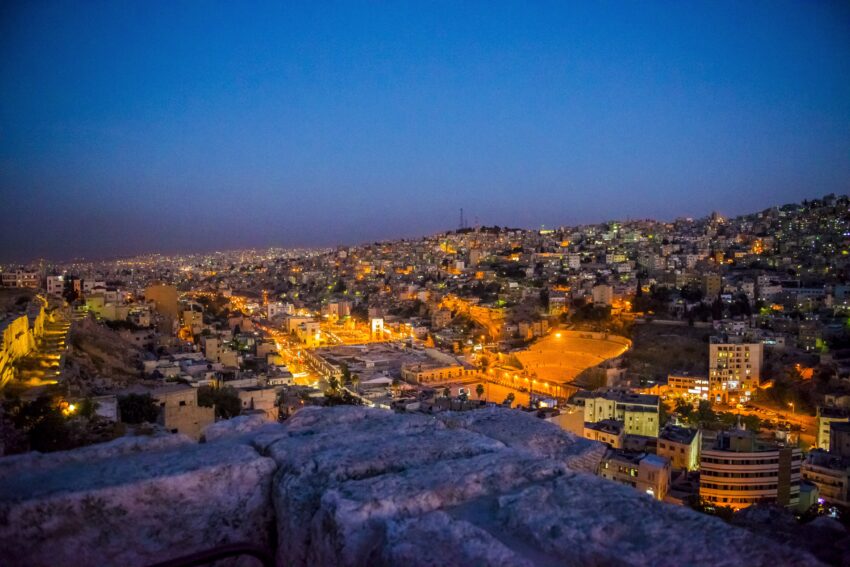
Jordanian Wine, Traditional Cuisine, and a Surprising Hipster Neighborhood
By Sharon Kurtz
GoNOMAD Senior Writer

Like most visitors, when I landed in Amman, I was itching to get to Petra and see the place that had filled my imagination since I was young.
My itinerary was planned with a couple of days in Amman first, and now I’m glad it was. Like most visitors to Jordan, I didn’t realize how fascinating Amman is. The capital and largest city is a mix of old and modern, spanning several empires and inhabited since Neolithic times.
Looking to play amateur archaeologist? Visiting the Amman Citadel and the Roman Theater will feel like traveling back in time.
Amman: A Vibrant City
Amman is vibrant and alive, with hidden gems like cafes, culinary delights, and fascinating neighborhoods where tradition and modernity meet.
It hosts countless attractions and exciting sights connecting tourists with the local culture. It’s an underrated destination well worth exploring.
On a recent visit to Jordan hosted by The Jordan Tourism Board, I was part of a small group of journalists. Three unique experiences in Amman stood out from all the rest.
Tasting Jordanian Wine in Amman
Wine and Jordan are something you wouldn’t naturally put together… but this area has a long tradition of winemaking, dating back to Nabataean times. It’s even been suggested that the wine Jesus was served during the Last Supper came from what is Jordan today.
After landing in Amman on an overnight international flight, we were jet lagged and dragging. But ever the professionals, we rallied and were up for what was soon to be an extraordinary evening.
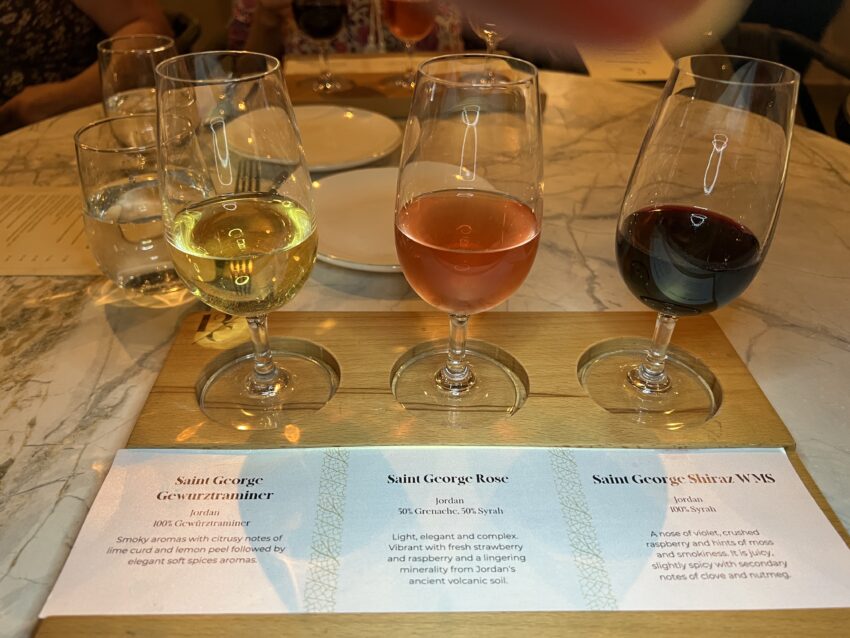
Our first stop in Amman was 13/C Wine & Spirits, the retail wine store and headquarters for Zumot Wines. They have been one of the major players in the wine and spirits market in Jordan since 1954.
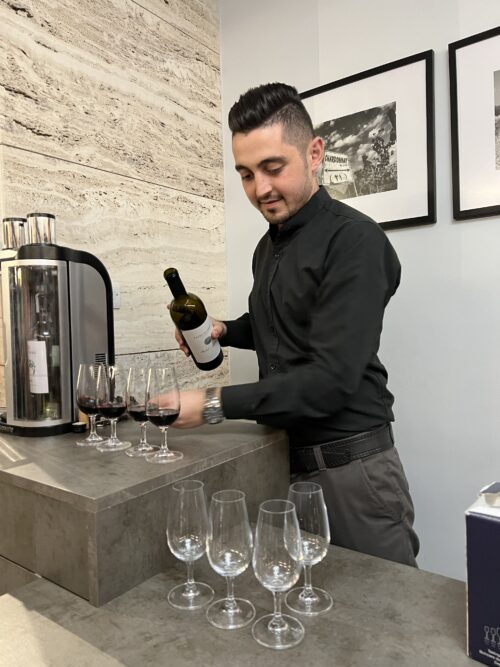
That’s when founder Bulos Zumot started a vineyard, resurrecting the lost art of making wine in modern Jordan. Today,
Saint George Wines of Jordan has 19 varietals and has won an impressive 32 medals in international competitions.
Khaled Zumot, the managing director, greeted us at the door and ushered us into the tasting room; the floor-to-ceiling display of wine bottles looked like sparking gems.
400-Acre Vineyard in Mfraz Province
The 400-acre vineyard is in the northeastern Mfraz province, neighboring Syria and Iraq. Their 100% organic winery produces over 200,000 bottles per year. The chief market for Jordanian wine is domestic, primarily in the tourism trade.
Khaled explained, “My brother Omar is the winemaker, and this is our family business.”
He shared the challenges of growing wine grapes in a Jordanian desert climate and the family’s dedication to reviving the art of winemaking in Jordan, striving to put Jordanian wines on the map.
I spied a beautiful blue bottle on the shelf, and Khaled educated us on the Jordanian spirit called Arak–then offered us a taste.
The milky white distillate had a strong anise flavor, like ouzo or raki. Khaled explained “that the knowledge of drinking Wine in Jordan is less common than drinking beer or whiskey. The locals prefer Arak, the traditional spirit we have with food, not an aperitif.”
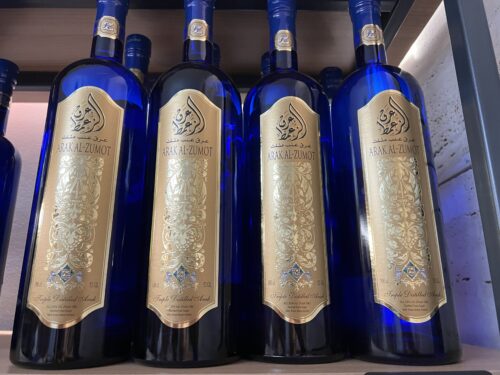
“We are in an area that has produced wine for thousands of years. All history was lost, and in the past 70 years, we had to start from scratch, finding a way to grow wine grapes that thrive in Jordanian soil and climate.
With all respect, we are living in an Islamic country. We must obey the Islamic rules here. But above all, we are a country that will produce wine again as they did in the past ages.”
Bar in the Back—an Interactive Food and Wine pairing experience
Our first evening in Amman was about to get even better for this troupe of travel writers.
Very conveniently, there is a restaurant gem attached to the wine shop called
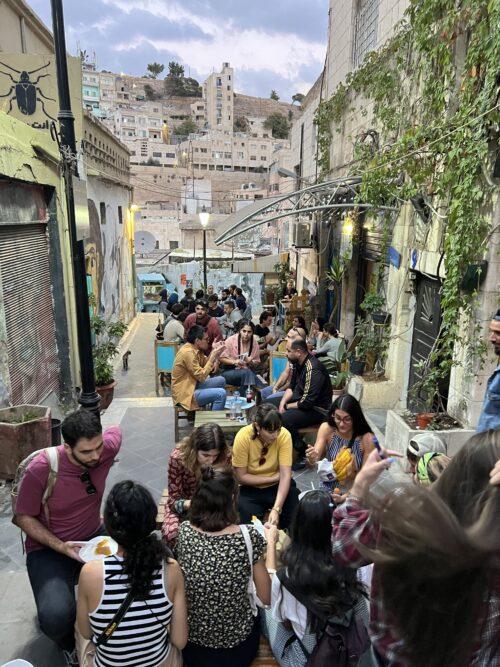
Bar in the Back. Accessed through the store, getting there was akin to solving a puzzle. A bit like a “speakeasy,” we entered a ‘secret’ door and emerged into a modern, clean space buzzing with people.
The intimate area had a stylized modern decor with exposed beams, blond wood accents, and a showstopping oval marble-topped bar.
A place suited to gourmets and epicureans, we were led to a table on a cozy outdoor patio open to the night sky.
Believing that wine is best enjoyed with good food and friends, we tasted five different Saint George wines, and the accompanying small plates were perfectly paired and artistically plated.
Curated by a sommelier and chef, they created a welcoming, fun wine-tasting event.
Wine-Battered Fries. Yup
My favorites were the eggplant with sesame and grape molasses, blade steak with wild mushroom polenta, and wine-battered fries (yes, that’s what I said).
The mascarpone cheesecake topped with a mix of fig jam, cinnamon, and cardamom paired perfectly with the Saint George Sweet Muscat.
Even though it was early in the evening, the place was humming and great for people-watching. One couple looked as if they were on a date—the woman beautifully dressed in traditional garb, the gentleman in a sport coat.
Another table of young people was ready to party; the young women dressed as if they could have been out on the town in any Western city. The evening was a spectacular start to our adventure in Jordan.
Amman’s Hipster Neighborhood: Jabal al-Weibdeh
The Jabal al-Weibdeh is one of the older neighborhoods of Amman, filled with coffee shops, bars, and street art— the painted murals interspersed with crumbling walls and decaying structures. The roads are rough, sidewalks are potholed, and you’ll step in the mud even if it’s not raining.
The bohemian hipster neighborhood is an artist’s haven with rich historical roots. Found between the Old City of East Amman and the Gentrified West Amman, the area is redefining itself while maintaining its fascinating past and preserving its integrity.

Overlooking the heart of Amman, the Darat al Funun, which means “A Home for the Arts,” is housed in three historical buildings of the 1920′. Alongside, the archaeological remains of a sixth-century Byzantine church are built over a roman temple. Abandoned for many years, Khalid Shoman’s interest in the Arts committed him to bringing this unique site back to life; the foundation’s mission is to support Arab artists.
Millennials Anas Amarneh and his sister, Lana, launched the tour company,
Through Local Eyes, to show people there’s more beyond Amman’s recognized tourist sites. They have been sharing their experiences and the challenges and achievements of local graffiti artists, break dancers, and beatbox artists in Amman.
“This is the destination for artists and poets,” Anas said as he led us up and down the neighborhood’s hilly streets.
A two-hour cultural walking tour of old Amman opened a window into Amman’s sometimes hidden or ‘underground’ artistic expression.
We felt the passion in the voices of these two talking about Amman, the city they love.
The Importance of Food in Jordanian Culture
Food is not only essential to life but is also an art form and a defining part of Jordanian culture. It closely intertwines food with community and social ties.
We experienced a bit of both at the Jordan Heritage Restaurant.
There’s a proverb in Jordan that says, “Even when you’re full, you can still always eat 40 more bites of food.” This maxim signifies the importance of generosity and hospitality and the significance of food in Jordanian culture.
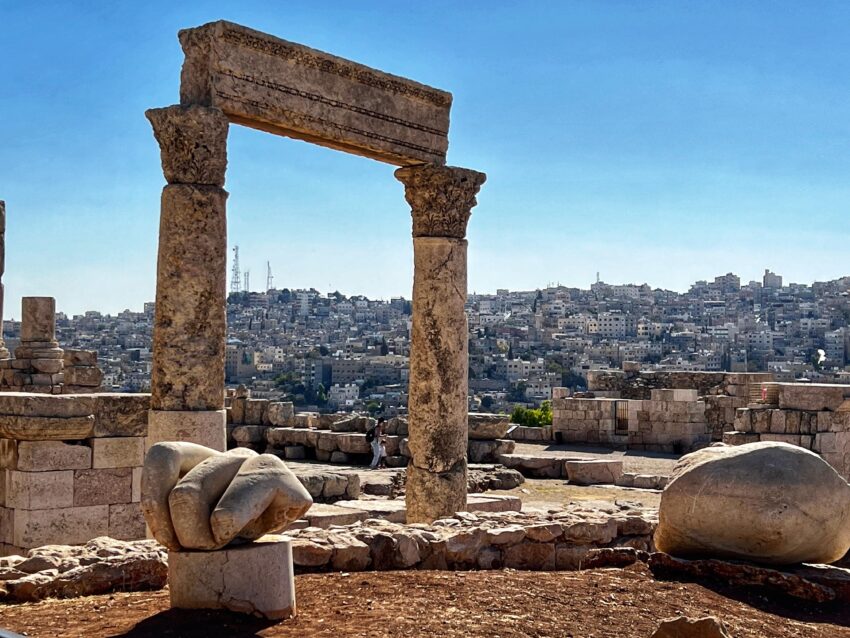
The Jordan Heritage Restaurant is rich in flavors that nourish the soul, extracted with love from their shared food heritage. The restaurant research and documents Jordanian Heritage as part of a non-profit company with a broad outreach.
As part of their mission, they have studied traditional cuisine and ingredients and opened the first authentic Jordanian cuisine restaurant. They offer more than 90 historical dishes, each bearing flavor, experience, and a journey from all the emirates of Jordan.

We felt the magic connection with Jordan while tasting each dish.
Seated on the lawn of the restaurant in a lovely old house on a warm evening with twinkle lights strung through the trees, the sounds of the neighborhood melded with Jordanian music playing on the speakers. At one point, a haunting call to prayer rang out. There’s nothing like that distinctive sound to set the time and place.
An Extensive Menu with 90 Choices
Even though the menu was in Arabic and English, it required more than a bit of coaching to figure out what to order from the extensive list of choices on the menu.
With over 90 dishes, each dish could be chosen with different combinations of proteins; goat, lamb, and chicken.
We shared Ajloun, a salad with walnuts, green onions, bulgur, chopped tomatoes, rocca leaves, and raisins, and Gras Za’tar, pillows of salted dough stuffed with local thyme, onions, and Jordan olive oil.

Mansaf is one of the most beloved dishes in Jordan; the three main components are rice, lamb, and jammed.
Jammed, a hard dried out and fermented goat milk yogurt. It has a sour and salty taste and an undeniable goat flavor; go easy— it is an acquired taste.
Kanafeh in the Levant
Kanafeh is a popular dessert throughout the levant, primarily known in Palestine and Jordan. Cheese is paired with semolina, drenched in sticky rose syrup, and topped with a pinch of ground pistachios.
The cheese on the bottom tastes like mozzarella, while the top crust is crunchy and gooey.
Amman, at first glance, seems noisy and noxious with a Big-City vibe. But its old-fashioned charms are well worth seeking out.
The Jordanian capital is a worthwhile stop for its history, Roman ruins, restaurants, and fascinating neighborhoods.
Although Sharon’s visit was hosted by The Jordan Tourism Board, all opinions are her own.
- Oakland: Discover the City’s Unique Neighborhoods and Cultural Heritage - September 13, 2024
- Slovenia: Forests, Vineyards, and Medieval Villages - August 8, 2024
- Peru: Visiting the Top Sites with Indigenous Women - August 2, 2024





